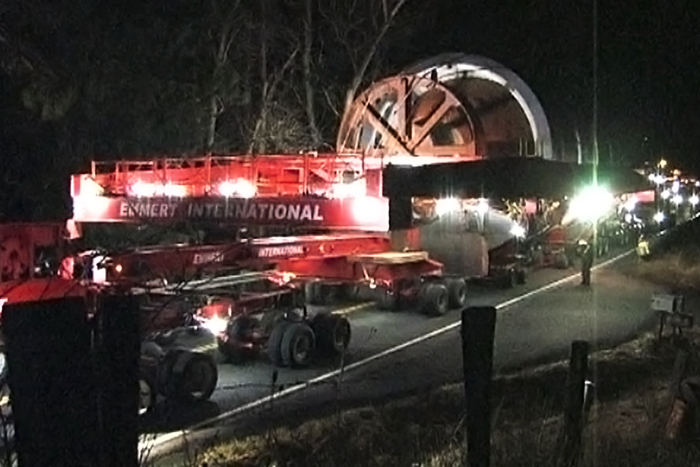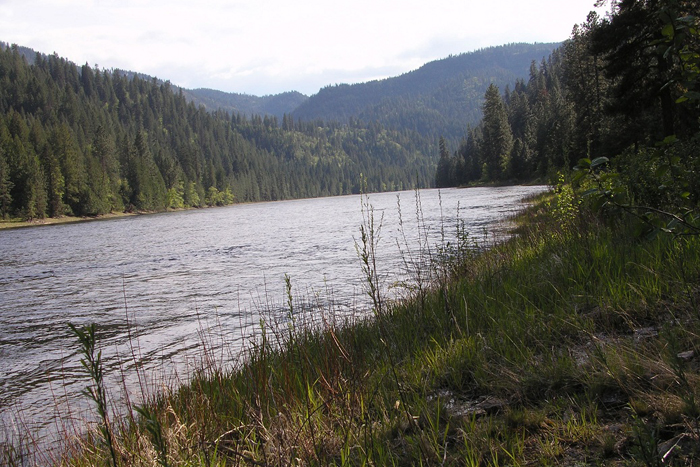Equipment "Megaloads" on Roads Add Twist to Tar Sands Debate (Op-Ed)


Bobby McEnaney is senior lands analyst at the Natural Resources Defense Council (NRDC) and deputy director for their Western Renewables Energy program. He contributed this article to Live Science's Expert Voices: Op-Ed & Insights.
I was born and raised in Montana and Idaho, two states with unparalleled beauty that lie in a region now under assault from gigantic truckloads of oversized oil-processing equipment heading to the tar-sands oil fields of Alberta, Canada.
For several years now, NRDC has helped local groups fight the transport of massive truckloads of tar sands mining equipment through one of the nation's most remote and scenic parts of the United States, shipments the oil industry continues to push for as tar sands processing operations expand in Canada.
In 2012, NRDC challenged ExxonMobil's plan to truck "megaloads" of mining equipment up to Canada through one of the most scenic mountainous highways in the country — U.S. Route 12, which winds through Idaho and Montana. These megaloads shipments are prefabricated mining components, and they are preposterously large — approaching 400 feet long, 22 feet in width, and over 20 feet high. To put that in perspective, one could place five typical diesel semi-trailers lengthwise, and three deep, to approximate the relative footprint of a typical megaload truck shipment.
At that time, ExxonMobil was unable to find a route on the U.S. interstate system that could accommodate those monstrous loads due to overpass height restrictions. So instead, the company came up with a plan to send hundreds of these megaload trucks up U.S. Route 12 through the Clearwater Wild and Scenic River passage in Idaho and the Lolo Pass through Montana — transforming a winding and isolated two lane highway surrounded by the largest wilderness area in the lower 48 into an industrial corridor that would serve the tar-sands industry.
Thanks to local groups and activists who fought this scheme — including All Against the Hall, Fighting Goliath, and Idaho Rivers United, along with the Nez Perce Nation — state and federal courts intervened last year to stop the use of the U.S. Route 12-Lolo Pass route until additional environmental analyses could take place.
The notion that pervasive megaload shipments would harm the solitude and pristine qualities that define the Clearwater corridor was further reinforced last month by an assessment released on April 8, 2014 by the U.S. Forest Service; "There are many places in the Northern Region and Pacific Northwest where the quality of the resource is recognized by a formal designation such as National Historic Trail, Wilderness, or Wild and Scenic River, but nowhere are there so many within the same area with such quality access as there is here … many perceive that use of the Highway 12 corridor as a frequent route for oversize hauling could affect the unique setting, recreational experiences, and cultural meanings, and special designations found here and nowhere else."
Get the world’s most fascinating discoveries delivered straight to your inbox.
Picking up the pieces
Since 2012, other tar sands providers have picked up where ExxonMobil left off. With Lolo Pass off the table, tar sands producers enlisted the primary shipper, Omega Morgan, to formulate an alternative, more circuitous, route through Oregon, Idaho and Montana. This time, the megaloads shippers have targeted U.S. Route 93, which travels along a no-less-pristine and isolated 7,000-foot Lost Trail Pass that intersects the borders of Idaho and Montana. These new shipments are making their way through some of the most rugged country to be found anywhere. The route includes the incomparable Craters of the Moon National Monument, the Salmon River corridor, Idaho's unique Camas Prairie (home to the some of the largest intact cold freshwater springs in North America) and Montana's Blackfoot River corridor. [All Yours: 10 Least Visited National Parks ]
In the last few months, oil-industry equipment truckers have committed between eight to ten megaloads to test out Route 93. What is notable is how similar the actions of the shippers are to what transpired in the ExxonMobil experience. When Exxon committed to Route 12, the Clearwater National Forest Service Supervisor Rick Brazell supervisor sent a letter to the state of Idaho signifying concerns about the hastiness of allowing megaload shipments given the lack of analysis and consideration of how key environmental resources, tribal concerns, and important recreational activities might be impacted, "[u]ntil we have clear understanding of these potential impacts, I cannot support authorization of such oversized loads through the National Forest or within the Wild and Scenic River Corridor."
Despite that declaration, the state of Idaho "ignored that request" and allowed further transportation of the loads, with the Forest Service ultimately backing down. But on the behest of business owners, the Nez Perce, and regionally environmental organizations, U.S. Chief District Judge Winmill ruled that the Forest Service "acted unlawfully" by not managing for the potential impacts to federal resources caused by these shipments, and further halted shipments until a robust environmental and socioeconomic analysis of the impacts was conducted.
This same pattern exhibited by the shippers and the states for the Lolo Pass route is seemingly being repeated for this latest trance of shipments. For instance, in Oregon, Headman Chief Carl Sampson of the Walla Walla Tribe noted in concert with legal action being initiated on his behalf, that the Walla Walla Tribe did not have an opportunity to comment about a permit that was issued for three megaloads shipments that traversed the reservation, "And now here we are in the middle of winter, with no formal notification, no tribal consultation, no information to our tribal members at our monthly council meetings, let alone our elected officials of the board of trustees or general council…"
Megaloads won't work
I find it incredulous that tar-sands producers have convinced themselves that the megaloads plan is even logistically feasible in the rugged and isolated region of the Rockies. And with that ruggedness comes inherent hazards in attempting to transport hundreds of megaloads through narrow mountain passes.
The initial experiences with these shipments are already proving that theory true. As reported by numerous observers, the first ExxonMobil shipments along Route 12 on the Clearwater River knocked down trees and utility poles, causing power outages to the nearby northern Idaho towns of Pierce and Weippe. The more recent shipments through the southerly Highway 93 route have been plagued by a host of problems and delays. For instance, one test shipment became stuck on Lost Trail Pass when the tires became iced in. Linwood Laughy, a resident on US 12, who along with his wife Borg Hendrickson, were some of the first to take note of the megaload situation, has been tracking the latest shipments: "Now 70 days from Umatilla [Oregon], the mega-load has traveled 900 miles, averaging 13 miles per day. In another 300 miles it will reach Canada, and then in 600 more, its tar sands destination. In November Omega Morgan predicted 20 days for the entire trip."
As these megaloads make their way up Highway 93, I remember a popular bumper sticker in Montana that morosely joked "Pray for me, I drive Hwy 93!" This was such a common catchphrase, even the Montana Department of Transportation played off 93's reputation by highlighting the bumper sticker on its website, the same agency now in charge of permitting megaload shipments.
These are extremely dangerous roads, where snowstorms and icy weather can turn nasty at the drop of a hat. This is no place for megaloads of truckloads of oil-processing equipment to travel in the first place. It is yet another example of why we need to reign in the climate-threatening operations of the tar sands industry — not shipments of oil equipment through our nation's environmental treasures. [The Time for Wind and Solar Energy is Now (Op-Ed )]
It's time we stopped jeopardizing our precious nation's natural resources for the sake of tar-sands industry profits and invested instead in clean energy — and our children's future. That is something everyone who cares about the wild and scenic river areas of the world should eagerly embrace.
Reports from the Edge, a companion series to This American Land on PBS, produced the video about the "megaloads" fight along a scenic road in Idaho. Follow all of the Expert Voices issues and debates — and become part of the discussion — on Facebook, Twitter and Google +. The views expressed are those of the author and do not necessarily reflect the views of the publisher. This version of the article was originally published on Live Science.





